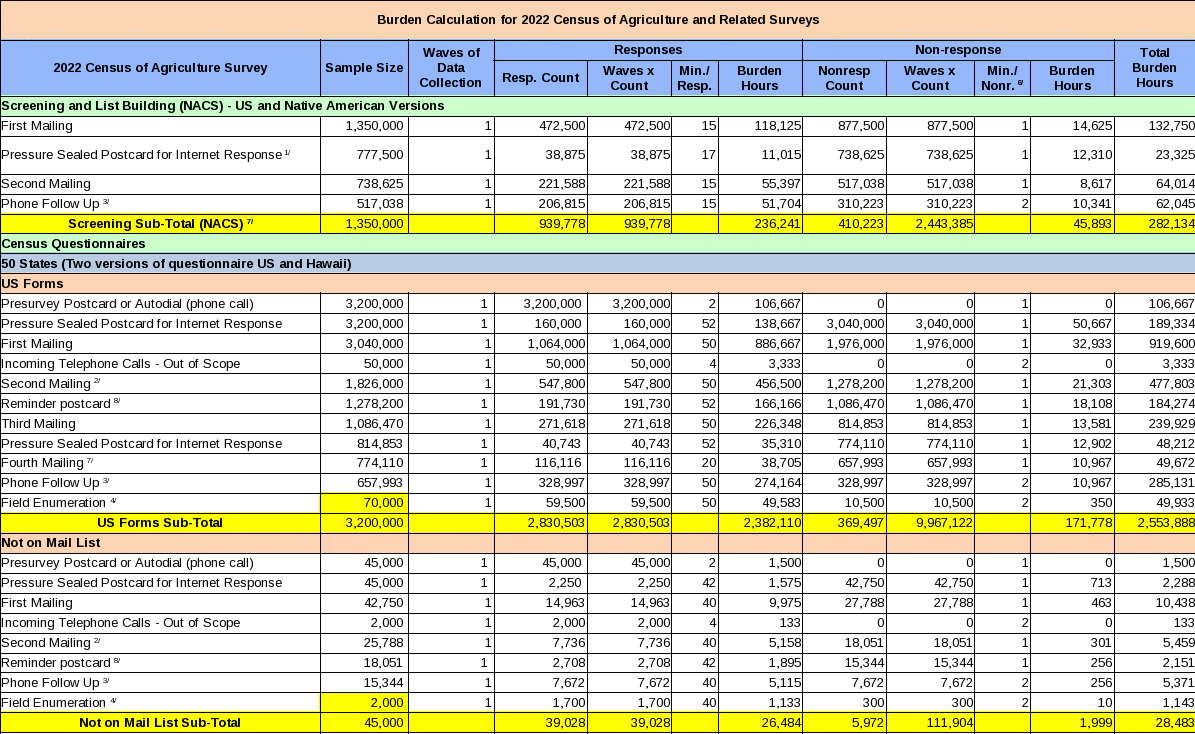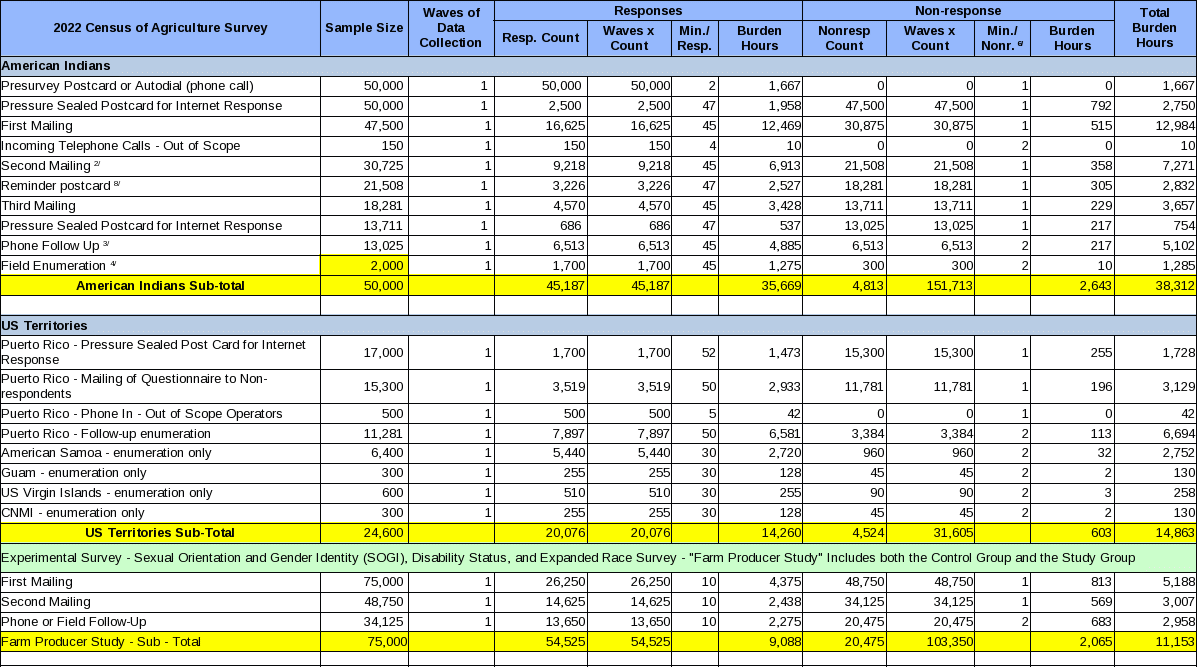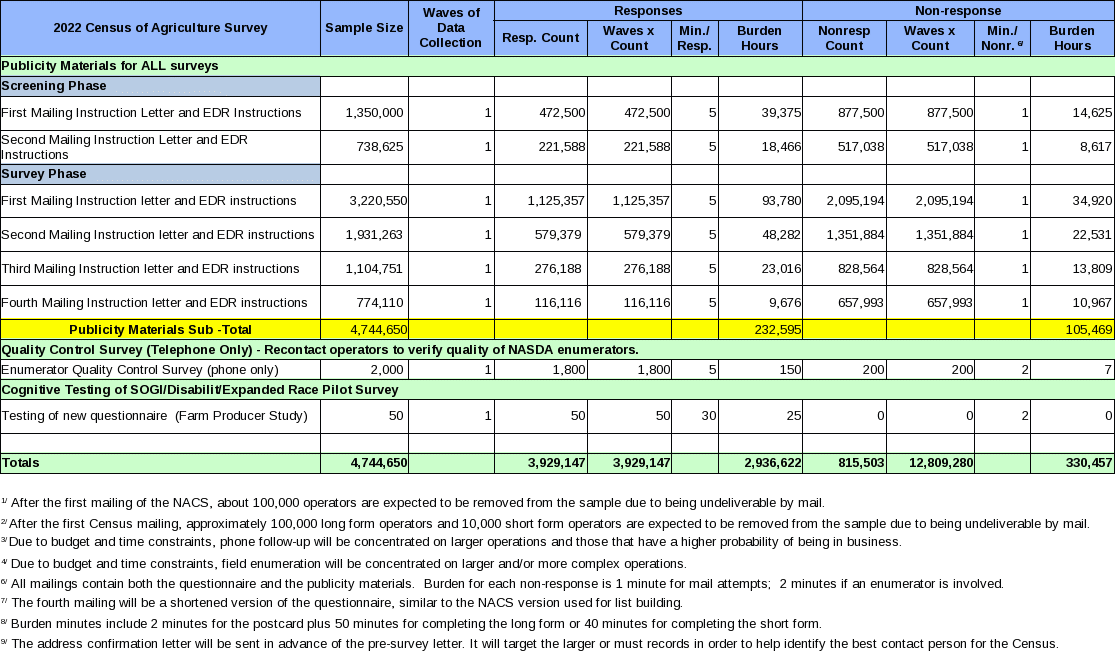Supplemental Supporting Statement Part A for Substantive Changes Sept. 2021
0226-AgCens-SSA 2022 - Substantive Change Request - 16Sept2021.docx
2022 Census of Agriculture - Substantive Change Request
Supplemental Supporting Statement Part A for Substantive Changes Sept. 2021
OMB: 0535-0226
Supplemental 1Supporting Statement Part A
Substantive Change
OMB No. 0535-0226
TERMS OF CLEARANCE: The NASS research study referenced in the supporting statements is experimental and is intended to assess the impact of including SOGI and Disability questions on survey response rates and measurement error associated with different modes of administration. The findings will inform whether and how to include these questions on the 2027 NACS. These modified survey documents will be included in a substantive change request.
NASS Reply: This is the substantive change request as defined in the Terms of Clearance in the previous approval.
JUSTIFICATION
This submission is for a substantive change request to our approved clearance. This change request provides details for an experimental data collection that will collect data on agricultural decision makers’ sexual orientation and gender identity (SOGI) and disability status. This voluntary experimental data collection will be called the Farm Producer Study and will take place in late 2021. This experimental data collection was mentioned in the original clearance.
Initially, NASS proposed to test expanded racial categories for Asians, Native Hawaiians/Other Pacific Islanders and additional ethnicity categories for Hispanics in addition to the disability and SOGI questions. The expanded Asian/Native Hawaiian/Pacific Islander/Hispanic categories have been well tested by the Census Bureau and their presence is unlikely to impact response rates. Thus, after further consideration, it became apparent that expanding these questions depended on available space on the Census of Agriculture questionnaire and how the results could be published differentially across the nation to reflect the differential presence of these populations. Neither of these would be well informed by this study. Therefore, we decided it was best to focus on the disability and SOGI questions.
1. Explain the circumstances that make the collection of information necessary. Identify any legal or administrative requirements that necessitate the collection. Attach a copy of the appropriate section of each statute and regulation mandating or authorizing the collection of information.
The USDA’s National Agricultural Statistics Service conducts the quinquennial Census of Agriculture in years ending in 2 and 7. The Census is the leading source of information about farms and ranches and the people who operate them. It is the only uniform, comprehensive agricultural data set for every state and county or county equivalent in the United States, including detailed data at the county level with respect to race, ethnicity, and gender.
Since acquiring the Census in 1997, NASS has revised and added questions to more fully capture the characteristics of farm producers. NASS now collects data on up to four producers instead of one as in 1997. Questions identifying veterans and new or beginning producers have been added. Beginning in 2017, the roles of women, minority, and other under-served producers have been more fully captured through decision questions, which enables USDA program agencies to measure progress in serving those traditionally underserved against an external benchmark.
NASS is considering adding questions on sexual orientation and gender identity (SOGI) and disability status for the 2027 Census of Agriculture. As a first step in this process, in December 2021, NASS will conduct the Farm Producer Study to assess the potential effect of SOGI and disability questions for the Census of Agriculture on response rates and measurement error. The results of the study may lead to a more robust demographic data product and assist regulatory agencies, producers, state governments, processors, and other USDA agencies in administering and monitoring program effectiveness.
USDA agencies with related missions and themes include the Farm Service Agency (FSA) and the Natural Resources Conservation Service (NRCS). FSA administers farm commodity, crop insurance, credit, environmental, conservation, and emergency assistance programs for farmers and ranchers. It uses Census of Agriculture data to determine eligibility criteria for beginning farmer loans; establish targets for increasing lending to beginning farmers, socially disadvantaged producers, women producers; and to target loan funds in the farm ownership and operating programs for applicants from underserved populations. The proposed study data have the potential to help determine baseline numbers for outreach efforts to farmers with disabilities and LGBTQ+ producers.
NASS Census of Agriculture data supports NRCS goals of reducing soil erosion; increasing wildlife habitat; protecting surface water and groundwater; providing incentives for agricultural producers to implement conservation stewardship and environmental protection measures; and increasing lending to LGBTQ+ farmers and farmers with disabilities. These data would also allow NASS to further support other USDA agencies in conducting educational and outreach activities; piggybacking on related activities helps to maximize limited resources and better serve the needs of all producers.
The separate data collection of agricultural decision makers’ sexual orientation and gender identity (SOGI) and disability status is also consistent with the Executive Order on Advancing Racial Equity and Support of Underserved Communities through the Federal Government and is one step towards responding to requests to the Federal Register Notice associated with this Information Collection Request.
2. Indicate how, by whom, and for what purpose the information is to be used. Except for a new collection, indicate the use the agency has made of the information received from the current collection.
No official estimates will be created from the Farm Producer Study. Instead, the data will inform future data collections, including the 2027 Census of Agriculture. The summarized results may also be shared broadly, including with other Federal Statistical Agencies and through research reports, journal articles, and presentations at appropriate professional conferences.
3. Describe whether, and to what extent the collection of information involves the use of automated, electronic, mechanical, or other technological collection techniques or other forms of information technology, e.g. permitting electronic submission of responses, and the basis for the decision for adopting this means of collection. Also describe any consideration of using information technology to reduce burden.
Producers included in the Farm Producer Study will be able to respond via a computer-assisted web interview (CAWI) or a computer-assisted telephone interview (CATI). Respondents will also be able to respond via a mail-back paper questionnaire.
4. Describe efforts to identify duplication. Show specifically why any similar information already available cannot be used or modified for use for the purposes described in Item 2 above.
NASS will use the same safeguards to remove any duplication of names as approved in the main Census of Agriculture clearance that OMB has already approved.
5. If the collection of information impacts small businesses or other small entities (Item 5 of OMB Form 83-I), describe any methods to minimize burden.
The same questionnaire will be used for both small and large operations. No additional burden will be placed on small operations.
6. Describe the consequence to Federal program or policy activities if the collection is not conducted, or is conducted less frequently, as well as technical or legal obstacles to reducing burden.
This experimental study is needed to assess whether collecting SOGI or disability questions impact response rates and to determine whether measurement error is associated with collecting gender identity data if no confirmation question is asked as would occur when the response is via paper questionnaire. The study is not intended for use in policy activities.
7. Explain any special circumstances that would cause an information collection to be conducted in a manner inconsistent with the general information guidelines in 5 CFR 1320.5
No special circumstances are associated with this information collection.
8. Provide a copy and identify the date and page number of publication in the Federal Register of the agency’s notice, required by 5CFR 1320.8 (d), soliciting comments on the information collection prior to submission to OMB. Summarize public comments received in response to that notice and describe actions taken in response to these comments.
The original notice soliciting comment on this information collection was published in the Federal Register on March 8, 2021 on pages 13279 - 13280.
Describe efforts to consult with persons outside the agency to obtain their views on the availability of data, frequency of collection, the clarity of instructions and record keeping, disclosure, or reporting format (if any), and on the data requirements to be recorded, disclosed, or reported.
NASS has met with numerous other agencies who have experience with collecting demographic data from the public or who have subject matter expertise. These individuals include:
Renee Ellis, Census Bureau, [email protected]
Jessica Holzberg, Census Bureau, [email protected]
Jennifer M Ortman, Census Bureau, [email protected]
Diane Willimack, Census Bureau, [email protected]
Valerie Ryan, National Center for Health Statistics, [email protected]
Julie A. Weeks, National Center for Health Statistics, [email protected]
James Dahlhamer, National Center for Health Statistics, [email protected]
Stephen Blumberg, National Center for Health Statistics, [email protected]
Aneta Erdie, Census Bureau, [email protected];
Kirk Greenway, Indian Health Service, [email protected];
Maura Spiegelman, Dept of Education, [email protected]
Doug Williams, Bureau of Labor Statistics, [email protected]
Rebecca
Morrison, National Science Foundation,
[email protected]
Christina C. Eller, White House Office of Science and Technology, [email protected]
Sylvia Fisher, Agency for Healthcare Research and Quality, [email protected]
Cristina Miller, Rural Development, [email protected]
Hanna Breckbill, Queer Farmers Convergences, Humble Hands Harvest [email protected]
Thomas Worth, USDA, Economic Research Service [email protected]
9. Explain any decision to provide any payment or gifts to respondents.
No payments or gifts will be given to respondents.
10. Describe any assurance of confidentiality provided to respondents and the basis for the assurance in statute, regulation, or agency policy.
There will be no changes in confidentiality from what was approved in the original submission.
11. Provide additional justification for questions of a sensitive nature.
Questions on race and ethnicity comply with the OMB Standards for the Classification of Federal Data on Race and Ethnicity. Operation income is asked in categories so that farms can be categorized by total value of production.
For the experimental data collection study of agricultural decision makers’ sexual orientation and gender identity (SOGI) and disability status, findings from the Interagency Technical Working Group (ITWG) on Sexual Orientation and Gender Identity (April 30, 2021) suggested that SOGI questions were not sensitive and had no higher item non-response than other demographic items in household surveys. However, NASS conducted nine cognitive interviews in preparation for this experimental data collection and found the question that asked for the respondent’s sex assigned at birth was sensitive and invasive for some respondents. Some respondents also felt the sexual identity question was sensitive. Despite the sensitive nature of these questions, their inclusion is the basis for this experimental data collection.
12. Provide estimates of the hour burden of the collection of information. Indicate the number of respondents, frequency of response, annual hour burden, and an explanation of how the burden was estimated.
This substantive change will create a slight reduction in total burden hours from the originally approved totals. The new totals for this information collection request, has a sample size of 4,744,650, a total number of 16,738,427 responses, and a total of 3,267,079 burden hours.
The table below shows estimates of the amount of time needed to complete the questionnaires based on results from the 2020 Census of Agriculture Content Test (OMB No. 0535-0243).
Cost to the public of completing a questionnaire is assumed to be comparable to the hourly rate of those requesting the data. Reporting time of 3,267,079 hours is multiplied by $36.97 per hour for a total cost to the public of $120,783,910.63.
NASS uses the Bureau of Labor Statistics’ Occupational Employment Statistics (most recently published on March 31, 2021 for the previous May) to estimate an hourly wage for the burden cost. The May 2020 mean wage for bookkeepers was $21.20. The mean wage for farm managers was $36.93. The mean wage for farm supervisors was $25.25. The mean wage of the three is $27.79. To calculate the fully loaded wage rate (includes allowances for Social Security, insurance, etc.) NASS will add 33% for a total of $36.97 per hour.



13. Provide an estimate of the total annual cost burden to respondents or records keepers resulting from the collection of information.
No capital/start-up or ongoing operation/maintenance costs are associated with this information collection.
14. Provide estimates of annualized costs to Federal Government; provide a description of the method used to estimate said costs which should include quantifying hours, operational expenses (such as equipment, staff, printing, and overhead), and any other expense that would not have incurred without this collection of information.
There are no changes to the overall costs, from what was reported in the original docket.
15. Explain the reasons for any program changes or adjustments reported in Items 13 or 14 of the OMB Form 83-I Burden (reasons for changes in burden).
This is a substantive change to the 2022 Census of Agriculture clearance. In the original approval, the total burden was 3,276,166. This change request involves an adjustment to respondent burden; a decrease of 9,087 hours, to a new total of 3,267,079. This change in burden is due to the new experimental survey’s (Farm Producer Study) reduced burden minutes. In the original approval the burden was estimated at 20 minutes per interview. After refining the project’s specifications and following cognitive testing, the burden was reduced to 10 minutes per interview. The total sample size and number of responses remain the same.
16. For collections of information whose results will be published, outline plans for tabulation and publication. Address any complex analytical techniques that will be used. Provide the time schedule for the entire project, include beginning and ending dates for the information collection, completion of report, publication dates and other actions.
The study’s data collection of agricultural decision makers’ sexual orientation and gender identity (SOGI) and disability status will take place in late 2021. No official estimates will be created from the Farm Producer Study. Instead, the data will inform future data collections, including the 2027 Census of Agriculture. The summarized results may also be shared broadly, including with other Federal Statistical Agencies and through research reports, journal articles, and presentations at appropriate professional conferences.
The study will provide insight into how NASS may incorporate these data series into future Censuses of Agriculture and other collections. If these demographic data are eventually available operationally, they will inform Executive Branch Agencies and Congress on the characteristics of agricultural producers to help identify program deficiencies and enhancements.
17. If seeking approval to not display the expiration date for OMB approval of the collection, explain the reasons that display would be inappropriate.
Approval of non-display of the expiration date is not being requested.
18. Explain each exception to the certification statement identified in Item 19, “Certification for Paperwork Reduction Act Submissions” of OMB Form 83-I.
There are no exceptions to the certification statement.
September 2021
| File Type | application/vnd.openxmlformats-officedocument.wordprocessingml.document |
| Author | hancda |
| File Modified | 0000-00-00 |
| File Created | 2021-10-04 |
© 2026 OMB.report | Privacy Policy